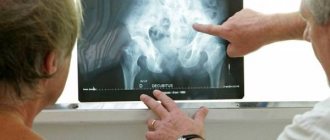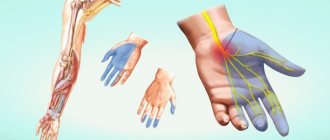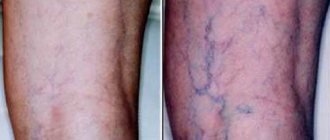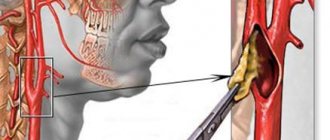What is the “small pelvis” and what is in it?
The “small pelvis” is an anatomical bone formation. In front it is represented by the pubic bones, in the back by the sacrum and coccyx, on the sides by the lower part of the ilium. Vertically, one can distinguish the entrance at the level of the ischial joint and the outlet formed by the coccyx, the ischial tuberosities, and the lower branches of the pubic symphysis.
The bone frame is designed to protect the organs lying inside. In people of both sexes, the rectum is located here. Its task is to accumulate and remove waste waste from the body. It lies directly on the sacrum. It has a length of up to 15 cm in an adult and stretches in diameter up to 8 cm.
The bladder lies behind the fatty tissue and pubic bones. When overfilled, the top edge protrudes above the joint.
Among women
In the small pelvis are located:
- ovaries - the place where eggs mature, sex hormones are produced and enter the blood;
- the uterus is an unpaired organ, similar to a pear, located with its tail down, lies between the bladder and rectum, narrows at the bottom and passes into the cervix and vagina;
- vagina - has the shape of a tube up to 10 cm long, connecting the genital slit and the cervix.
In men
The male organs in the pelvis are:
- prostate gland - produces a secretion that is part of sperm, located below the bladder;
- seminal vesicle - length 5 cm, width 2 cm, secretory organ, through the ejaculatory duct removes its product to the outside.
All organs are supported by dense ligaments of connective tissue.
Why does venous stagnation occur?
In women, this problem occurs more often and is accompanied by pain.
The following factors are considered to be the reasons for this phenomenon:
- The vessels have lost their structural elasticity.
- A malfunction of the nervous system caused spasms in the blood vessels.
- The integrity of the venous vessels is destroyed by bad habits (alcohol, smoking).
- A lifestyle without the necessary activity and sedentary work.
- Poor nutrition causing digestive system problems. Diarrhea and diarrhea appear, and a strict diet is dangerous due to vitamin deficiency.
- Women are susceptible to the influence of hormonal drugs and pregnancy. It `s naturally. affects blood circulation in the pelvic area.
- Tight underwear interferes with blood flow.
The blood flow deteriorates gradually and, accordingly, discomfort does not occur immediately.
In the initial stage, slight tingling sensations are observed, which then develop into intense pain.
Features of blood supply
We recommend reading: Primary prevention of cardiovascular diseases
Arterial blood comes from the abdominal aorta through the iliac arteries. The veins accompany the arteries, run parallel, and form venous plexuses around each organ. An important feature of local venous blood flow:
- a wide network of anastomoses, through which, on the one hand, auxiliary outflow is provided in case of thrombosis; on the other hand, infection quickly spreads between adjacent anatomical formations;
- unlike the veins of the extremities, the vessels do not have a valve apparatus, which causes rapid stagnation of blood in the pelvic organs;
- venous trunks located along the bone skeleton are tightly attached to the walls of the pelvis, so in case of bone injuries they do not collapse, but are wide open, which contributes to blood loss.
Diagnosis of pathology
If a woman or man discovers symptoms of blood stagnation in the pelvis, it’s time to see a doctor. Surgeons, phlebologists, and urologists are involved in the diagnosis and treatment of vascular disorders. Women also need to consult a gynecologist. After the examination, tests and instrumental examinations are prescribed:
- Ultrasound of the pelvic organs - the method is determined based on the situation;
- CT is an excellent way to detect tumors in organs;
- MRI is a reliable and accurate source of information about the structure of blood vessels and changes in organs;
- phlebography with a contrast agent is used less and less, but in some situations remains relevant (after the substance is injected into a vein, an x-ray is taken).
After diagnosis, the results are taken to the attending physician, he deciphers them and makes a diagnosis. Sometimes it is necessary to undergo several examinations to obtain reliable information.
Why does stagnation occur?
The causes of blood stagnation in the pelvic veins are associated with damage to the vascular wall or a mechanical obstacle to the blood flow:
- varicose veins - occurs due to a violation of the structure, elasticity, loss of hyaluronic acid by cells, hereditary predisposition;
- alcoholism and nicotine addiction - both factors destroy hyaline and cause varicose veins;
- disturbance of central regulation of blood vessels, spasm, which turns into loss of tone in diseases of the nervous system;
- prolonged sitting position at work, lack of movement during the day;
- irrational diet, passion for different diets that cause vitamin deficiency, constipation;
- For women, pregnancy history, uterine flexion and the use of hormonal contraceptives are important.
Wearing shapewear, corsets, belts, interferes with the outflow of venous blood, the pursuit of beauty leads to pathology
Prevention
It is easier to prevent the development of a disease than to treat it for a long time. To prevent vascular impotence, you need to follow simple recommendations:
- Avoid foods high in fat and hot spices, smoked foods, and fried foods. This will preserve the elasticity of the vascular walls.
- Stop smoking and drinking alcoholic beverages. Bad habits tend to have a detrimental effect on blood vessels.
- Walk and ride a bike regularly to maintain muscle and vascular tone.
- Sleep at least 8 hours a day, go to bed and get up at approximately the same time. A proper daily routine supports the normal functioning of the central nervous system.
- Avoid exposure to stress factors on the body (if it is impossible to treat problems more simply).
- To undergo preventive examinations annually, this will help to “capture” the pathology at an early stage, when it is easily treatable.
Following these rules will preserve men's health and avoid the unpleasant problem of impotence.
Blood stagnates in the pelvic area in women due to varicose veins and decreased elasticity of their walls. Fluid-filled veins lead to constant pain in the lower abdomen and reproductive dysfunction. Mostly middle-aged women suffer, although even in girls under the age of 18 the condition is detected in 20% of cases. At the age of 50 years, congestion in the pelvic organs is observed in almost 80% of women. The disease is poorly diagnosed and treated, although it significantly worsens the patient’s quality of life.
p, blockquote 1,0,0,0,0 –>
p, blockquote 2,0,0,0,0 –>
Venous stagnation is caused by two main reasons:
p, blockquote 3,0,0,0,0 –>
- Obstruction of the veins coming from the uterus and ovaries, for example, with adhesive disease, which causes an increase in pressure in the underlying areas of the veins and their expansion.
- Termination of venous outflow due to blockage of the vessel lumen by a thrombus. In this case, venous blood begins to flow through a branched network of collateral vessels with a weak valve system.
Venous system of the pelvis in women
In the vast majority of cases, stagnation occurs in the veins extending from the ovaries. It is extremely rare that dilatation of the veins lying in the thickness of the broad ligament of the uterus is recorded.
p, blockquote 4,0,0,0,0 –>
Clinical manifestations
Symptoms caused by blood stagnation cannot be considered typical, since they also occur in other diseases. But they should be remembered in the differential diagnosis of diseases.
Both men and women complain about the following:
- pain in the lower abdomen is prolonged, aching in nature or sharp, stabbing, radiating to the lower back, thigh, perineum;
- feeling of heaviness.
Accompanying various diseases, circulatory pathology manifests itself in different ways:
- stagnation of blood in the pelvis in women and men causes infertility;
- as one of the causes of inflammatory diseases in men, urethritis develops, prostatitis with pain when urinating, pain in the perineum, impotence;
- varicocele as a variant of varicose veins in men causes testicular enlargement on one side and pain;
- in women, the uterus prolapses, the menstrual cycle is disrupted, and bleeding increases;
- chronic hemorrhoids with pain in the anus, burning and itching.
With a long course of the disease, general symptoms are observed regarding changes in a person’s mental state: depression or anxiety, irritability, and tearfulness appear.
What are pelvic varicose veins
How are varicose veins of the pelvic veins formed? The principle of its formation in women is similar to varicose veins in the legs. The valves normally found in the veins that allow blood to be pushed upward towards the heart become less elastic and do not function fully. As a result, the blood in the legs stagnates and the veins dilate. We often see them in others as raised and nodular venous plexuses that can be painful, especially when standing.
These same veins exist in our pelvis, and their valves may also be poor at carrying blood to the heart. This means that the outflow is less than the inflow and some of the circulating blood accumulates inside the pelvic structures due to gravity, causing the veins to swell. These dilated, defective vessels are hidden inside our pelvis, causing pain and other discomfort in the pelvic area, but we cannot see them. Sometimes they become visible around the genitals (vulva, vagina), inner thighs, buttocks, or down the legs.
Fig.1. "Comparison of normal blood flow through a vein and disturbance of blood flow due to valve damage."
Now it is clear that in this condition the blood flow slows down, the blood stagnates in the vessels, the pressure in the veins increases, and they become deformed - they stretch, increase in diameter. Therefore, ultimately, the speed of blood circulation decreases, and this is a direct path to the formation of venous insufficiency. As a result, blood that should flow back to the heart instead remains inside the pelvis, causing what Western medicine refers to as “pelvic congestion” (excess blood flow syndrome). It puts pressure on such important organs as the uterus, ovaries with tubes, bladder and lower intestines with all the ensuing consequences for the intimate and reproductive health of a woman...
Symptoms of blood stagnation in the pelvis
The clinical manifestations of pelvic hyperemia syndrome may vary from person to person. The main symptom is constant (chronic) pain. It is felt by a woman in the lower abdomen and can radiate (spread) to the lower back, sacrum or groin area. The intensity of pain varies and it intensifies during sexual intercourse, after prolonged standing, before or during menstruation, etc.
When visiting a doctor, patients often present the following complaints:
- Discomfort in the lower abdomen;
- Irregular and painful periods;
- Haemorrhoids;
- Varicose veins of the external genitalia and vagina;
- Varicose veins in the legs;
- Lower back pain;
- Urinary problems;
- Chronic pelvic pain;
- Pain during and after sexual intercourse.
If a woman has more than two of the above symptoms, there is an increased likelihood of having pelvic venous stasis and varicose veins.
Possible harm to women's health
Pelvic congestion syndrome (PCS) can cause fertility problems and difficulties in women who have had two or more pregnancies. This condition can also cause the development of venous insufficiency in the lower extremities with varicose veins of the vulva and perineum. This happens because there is a direct connection between the venous plexuses of the uterus and appendages and the superficial network of the legs. This is why, in many cases of impaired blood flow and blood stagnation in the pelvic organs, women develop dilated veins in adjacent areas, especially on the inside or back of the thighs or calves.
Cosmetic defects caused by “protruding veins” and increased vascular patterns on the genitals and lower extremities are not the biggest problem with this syndrome. The danger of poor blood flow in the internal female organs lies in the multifaceted impact on many important functions of the female body.
Possible complications may be:
- Regular nagging pain in the lower abdomen of unknown cause;
- Psycho-emotional instability;
- Constant irritability, weakness, deterioration in performance;
- Decreased libido, anorgasmia;
- Ovarian hypofunction;
- Changes in the nature of menstruation;
- Inflammatory diseases of the uterus and ovaries;
- Problems with conceiving a child and carrying a pregnancy.
Diagnosis of congestion
Initially, a problem with microcirculation in this area can be identified if you perform a “female ultrasound” with a vaginal sensor. This method will allow the specialist to see the exact number, size and distribution of dilated veins in the uterus and ovaries, and optional Doppler measurements will help determine the parameters of vascular blood flow.
In advanced or difficult to differentiate cases, abdominal ultrasound, venography, laparoscopy and MRI are additionally prescribed to identify varicose dilatation.
Diagnostics
If stagnation in the pelvis is suspected, doctors use hardware examination methods to confirm or remove the diagnosis:
- Ultrasound - assesses the size of organs and the state of blood flow;
- venography - a contrast agent is injected into the inguinal vein followed by an x-ray; the procedure carries the risk of an allergic reaction to the drug;
- computed tomography - allows you to identify local varicose veins;
- magnetic resonance imaging - reveals signs of inflammation, changes in the location and shape of the pelvic organs, the structure and direction of blood vessels.
Prevention of circulatory disorders in the pelvis
To prevent the development of congestion in the pelvis and the associated adverse consequences for “men’s health”, it is worth changing your lifestyle, and it is better to do this at work too
- try to take breaks from sedentary work and fill them with physical activity;
- make your workplace more ergonomic - for example, buy a saddle chair and a high table;
- walk more - to the store, up the stairs, not to use the elevator, buy a dog for walks together, buy a subscription to the pool, to yoga courses, or just jump rope;
- to refuse from bad habits;
- switch to a healthy diet with limited sugar, salt, fatty and smoked foods;
- maintain optimal weight;
- have regular sex life.
A healthy lifestyle always helps reduce the risk of a variety of diseases. If it was not possible to avoid their manifestations, the first thing you should do is contact a specialist for a comprehensive examination and identify the cause of the disease. Self-medication may not only not help, but also harm the body.
Treatment requirements
In addition to drug therapy, the treatment complex necessarily includes gymnastic exercises and a diet. It is necessary to achieve normalization of sleep, quit smoking, and limit the consumption of alcoholic beverages.
The diet should include everything that prevents stool retention: liquid up to 2 liters per day, vegetables and fruits, fermented milk products, exclude sweets, fried and spicy foods. Replace fatty meat products with fish and poultry. Due to increased gas formation, it is better to exclude dishes made from legumes and cabbage.
What exercises can you do at home?
To relieve congestion in the pelvic veins, the following activities are recommended:
- swimming;
- jogging;
- jumping rope;
- yoga.
Hiking and cycling are not recommended.
This physical activity simultaneously trains the heart and blood vessels.
At home, you should spend 15 minutes daily on therapeutic exercises. Exercises shown:
- while lying on the mat, make circles with your legs as if riding a bicycle, alternating movements forward and backward;
- static exercises for the lower abdominal muscles - while lying down, lift and pull your pelvis towards you, hold in this position for 15-20 seconds, catch your breath and repeat 3 approaches;
- shoulder blade stand;
- imitate a half-squat position so that the thigh and shin make an angle of 90 degrees, hold for a minute.
Increased blood flow in the pelvic organs
The scheme and tactics for treating congestive processes are selected individually by the gynecologist, depending on the severity of this condition and the presence of certain symptoms. In any case, therapy should be comprehensive - aimed at restoring the tone of the venous walls and improving metabolic processes in the pelvic organs.
✅ The main ways to improve blood flow:
- The use of medications - phlebotropic drugs, vitamins and drugs that improve blood flow from venous vessels;
- Surgical intervention. Surgical treatment of the syndrome of “pelvic hyperemia” and varicose veins in the area of the pelvic organs, vulva and vagina is achieved by embolization of the pelvic veins, which can be recommended if conservative methods are unsuccessful or hopeless and only by a specialized specialist.
- Physical exercises, intimate Kegel training at home;
- Physiotherapy, manual techniques, etc.
If with p.p. Nos. 1, 2 and 3 are all more or less clear, we will focus on point No. 4. These include ways to improve blood circulation in the pelvis in women without resorting to invasive methods. The methods listed below to activate the movement of blood and lymph, reduce or eliminate venous stasis in the internal genital organs, can be used either independently or in combination with taking medications.
Only manual and similar treatment techniques, without the use of drugs, are carried out in order to prevent the development of stagnation. They are recommended for all women who lead a sedentary lifestyle or have the risk factors listed above!
Use of medications
Medicines that normalize blood flow can only be prescribed by a doctor after a complete examination. The following medications are used:
- Venza is a drug in drops that relieves swelling of tissues and increases the tone of the vascular wall.
- Aescusan - tonic drops.
- Ascorutin is a complex preparation of ascorbic acid and rutin, has a rejuvenating and antioxidant effect, normalizes cellular metabolism in the area of stagnation, and is a means of preventing inflammation.
Exercise 4. Walking on the buttocks
- Sit on the floor. Straighten your legs. Clench your hands into fists, bend your elbows and raise them slightly above chest level.
- “Step” forward with your right buttock along with your right leg straight.
- Then the left buttock “goes” forward.
- How long to walk? 20-50 meters!!! Just don’t start from 50 meters, otherwise there will be ridiculous injuries, as in the old joke: “Only your ears reached the battery.”
- You can walk on the floor 1 meter forward, 1 meter back if there is not enough space.
- This exercise is one of the best for increasing blood flow in the pelvic area; it is also an excellent prevention of hemorrhoids, etc. diseases
Treatment with folk remedies
The following folk recipes are used in treatment to improve pelvic circulation:
- a decoction of hawthorn fruits, dried raspberries, rose hips, motherwort, calendula flowers with the addition of orange peel. Brew for half an hour, drink as tea three times a day;
- a combination of licorice root, aralia, string, elecampane, rose hips, horsetail in equal quantities, infuse in a thermos overnight, drink ½ glass before meals;
- Boil a collection of thyme, calamus root, nettle, buckthorn bark, coltsfoot leaves for 5 minutes in an enamel bowl or brew in a thermos overnight, drink 100 ml three times.
Use herbal preparations at intervals of 2 weeks
Venous hyperemia of the brain
Most often, this disease is secondary and is a consequence of some intracranial and extracranial pathological process. The disease is diagnosed by measuring pressure in the ulnar vein, phlebography, and radiography of the skull. In the chronic form of hyperemia, metabolic changes and oxygen starvation of the brain occur, swelling develops, and increased intracranial pressure is observed. Early forms of the disease manifest themselves in the form of a decrease in the tone of the venous vessels, which is diagnosed by rheography or plethysmography.
The disease can be triggered by the following factors:
- Heart problems;
- Struma, aneurysm;
- Diseases of the bronchi and lungs;
- Tumor in the neck area;
- Head injuries;
- Dropsy of the brain;
- Obstruction of blood flow due to the presence of venous thrombosis.
Symptoms of venous stagnation in the brain
- One of the pronounced symptoms is the manifestation of increased headaches during bending and turning in different directions;
- Dilated veins in the fundus of the eye;
- The pressure in the veins is within 50-80 mm. water Art.;
- Sudden attacks of dizziness;
- Rumbling or noise in the head;
- Bluishness in the facial area. In the morning, swelling of the lower eyelids;
- Morning headaches are common;
- Fainting;
- Symptoms of venous stagnation in the head are expressed in the presence of decreased sensitivity of the limbs (numbness occurs), in mental disorders;
- During exacerbations of the disease, it is difficult for a person to lie down or lower his head;
- Increasing headaches due to emotional experiences or drinking alcohol.
Treatment
- To reduce venous pressure, aminophylline is usually prescribed (intravenous 2.4% solution 5.0-10.0 ml IV on glucose, IM or tablets);
- Glivenol, aescusan, troxevasin and detralex for oral administration reduce congestion;
- Furosemide, mannitol and diacarb are used to reduce the severity of edema;
- Treatment of venous stagnation of the brain is carried out using self-massage of the collar area to relieve spasm of the neck muscles;
- Laser-LED therapy is prescribed;
- Electrical stimulation;
- Various types of reflexology;
- Treatment of venous congestion in the head is carried out using herbal medicine.
Recommendations
To alleviate the course of the disease, it is recommended to follow a diet that excludes salt, spicy, smoked and fried foods, coffee, alcohol, and strong tea. Rolled oats cooked in water and without salt help relieve swelling.
If you experience a feeling of heaviness in your head, you can use garden parsley. Its crushed roots and leaves are steamed and infused for 30 minutes. and take 1-2 tsp 3-5 times a day, washed down with boiled water.
How to prevent stagnation?
Prevention of venous stagnation in the pelvic organs includes:
- cessation of smoking and excessive consumption of alcoholic beverages and beer;
- maintaining an active motor mode, walking, physical exercise, sports;
- adhering to reasonable dietary measures regarding the consumption of fatty foods, limiting food processing by frying and sweets;
- control over the amount of fluid you drink;
- organization of a work regime with provision of rest and warm-up to muscles every 2 hours.
Prerequisites include timely consultation with a doctor and treatment of inflammatory diseases of the genital area, hemorrhoids. This will eliminate unnecessary infectious components and prevent phlebitis and thrombosis of the pelvic veins.
Who is susceptible to blood stagnation in the pelvis?
This primarily applies to men who lead a predominantly sedentary lifestyle. Sedentary work is the most dangerous enemy for men's health. This is confirmed by research by scientists who have found that men whose profession involves constant sitting have a smaller sexual constitution than men with active physical work.
In addition to poor circulation, a sedentary lifestyle is often accompanied by excess weight, physical inactivity, pain and diseases of the spine, unbalanced nutrition and other negative factors.











